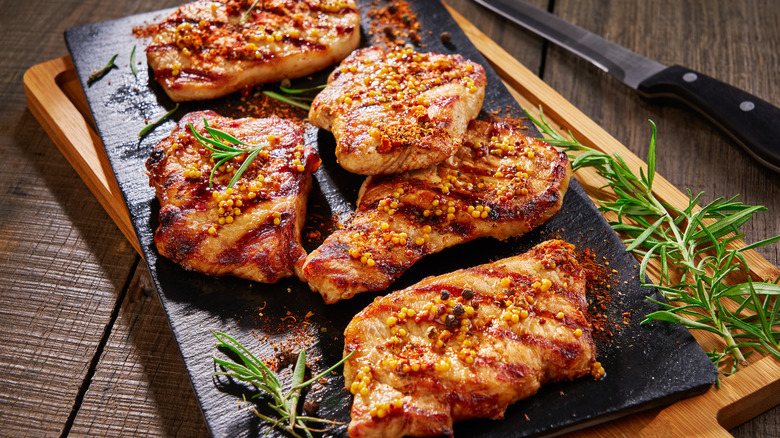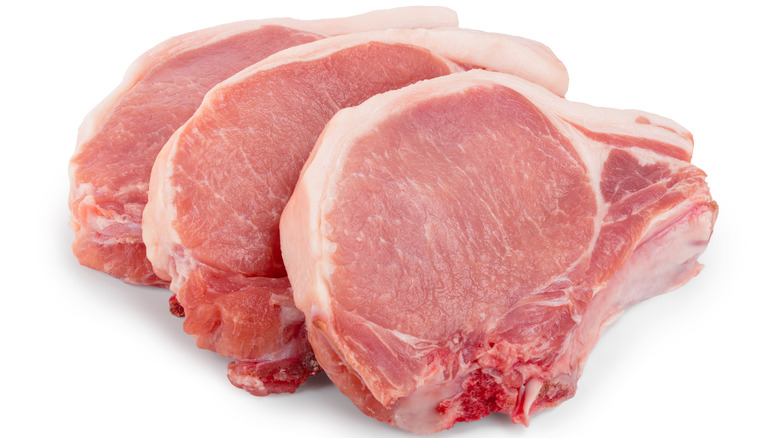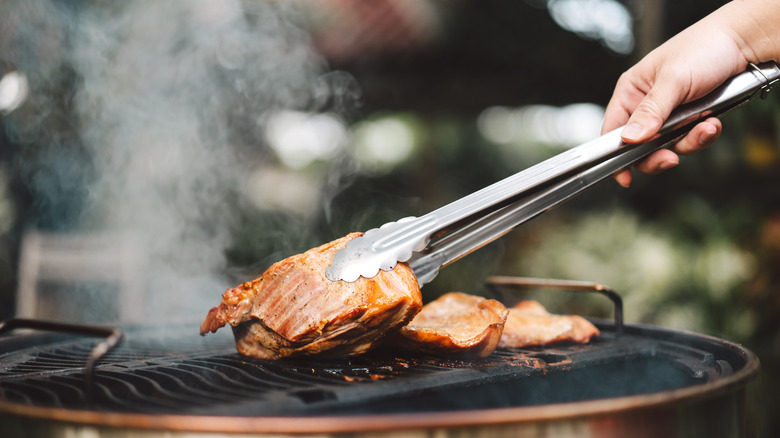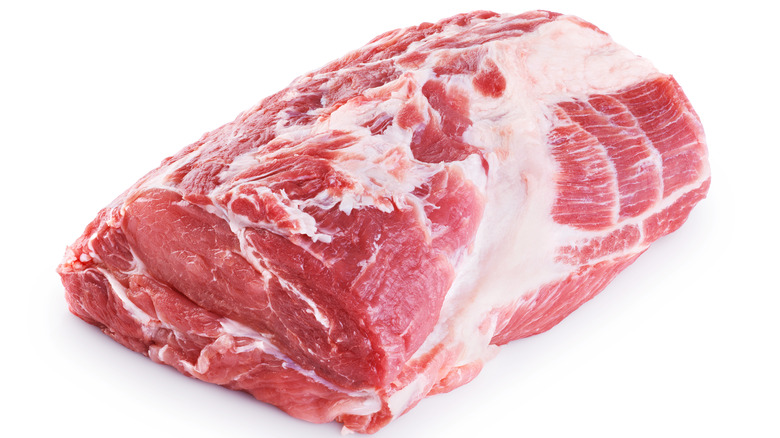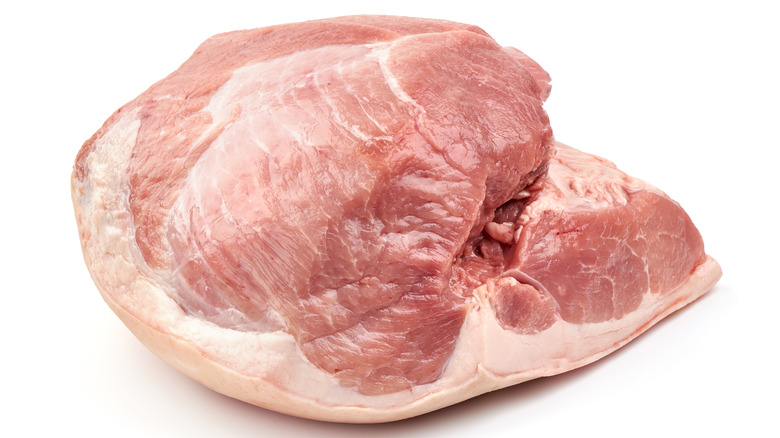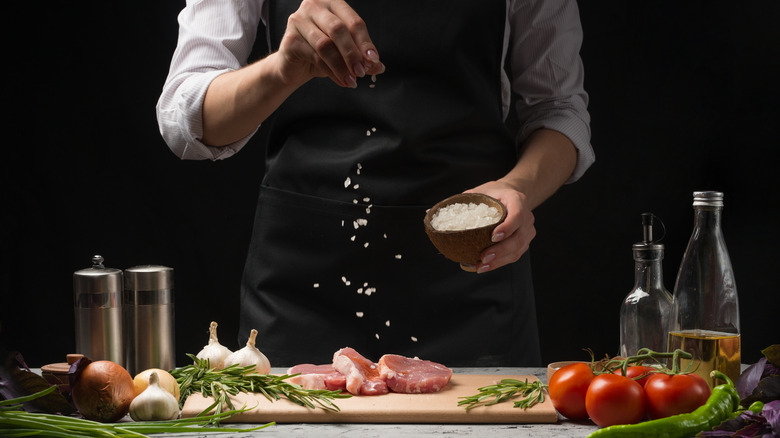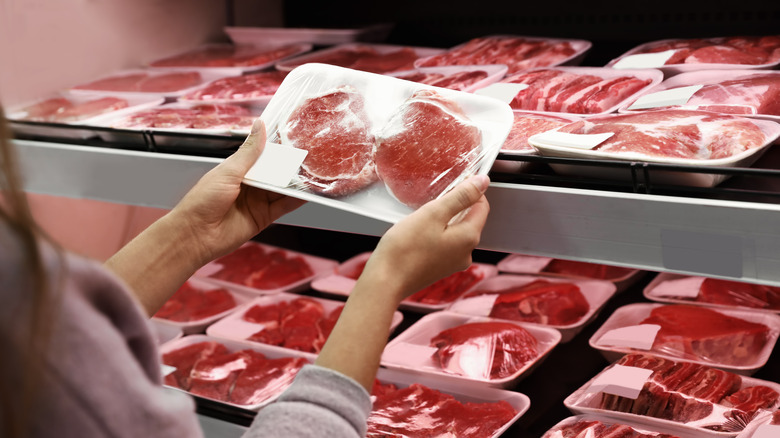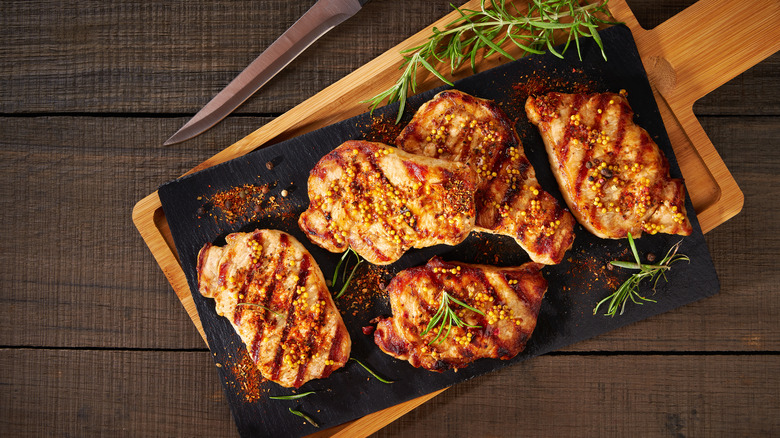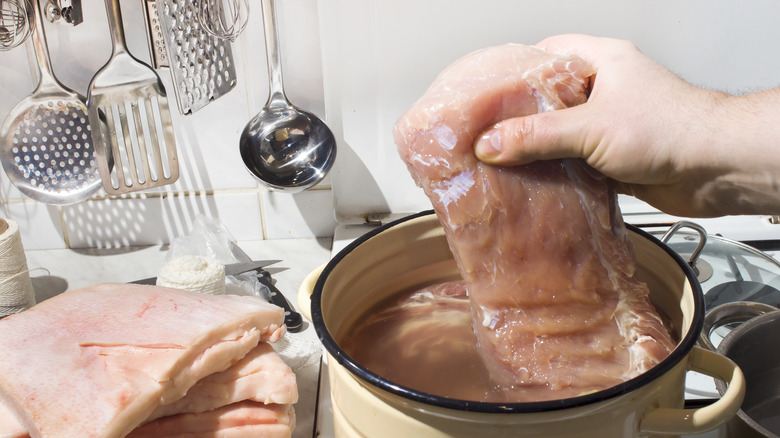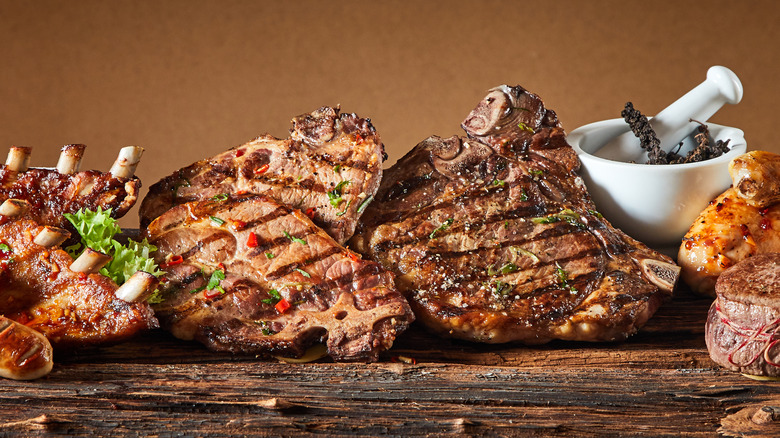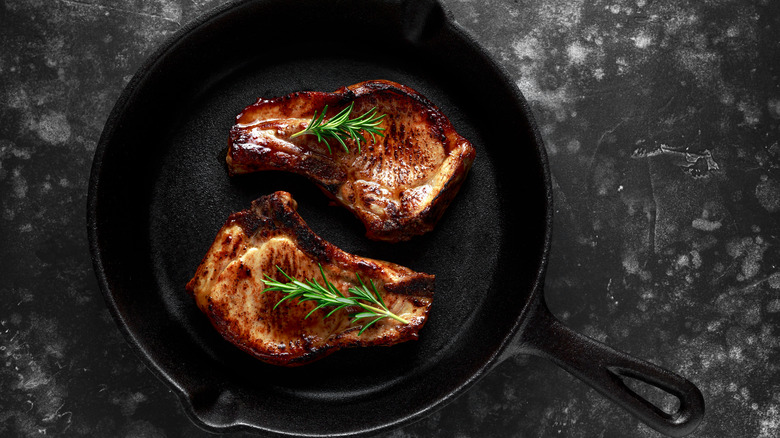Mistakes People Make When Grilling Pork Chops
When we picture a pork chop dinner, we probably picture it either Southern style — that is, deep-fried and paired with gravy and potatoes — or perhaps smothered under some cooked onions. Both can certainly be delicious. And of course, there's nothing wrong with enjoying pork chops in any way at all. But, you'll be opening a door to a whole new world when you try pork chops that have been cooked on a grill.
Pork chops are a great choice for a meal any day of the week, but they can have a reputation for being tricky. Plenty of us have probably tried to make them before, maybe not had the best results (that is, produced some tough, dry chops), and then given up. Take heart, though. It's time to give grilled pork chops another try. We really can avoid the mistakes we've made before. It's all about a few simple rules, like making sure you don't overcook the pork chops and give the meat time to rest. And while these ring true for many cooking methods, grilling pork chops can mean you're in for some smoky seared deliciousness!
The perfect pork chop will be well seasoned, moist, and incredibly satisfying. Once you get a pork chop right, you'll be coming back for more all the time. With that in mind, here are some common mistakes people make when grilling pork chops and how to avoid them.
Choosing a light pink pork chop
That rosy, bone-in, mouthwatering pork chop might be appealing to the eye, but it is actually not the best cut for the grill. "The light pink color betrays very lean muscle meat," cooking instructor Viola Buitoni told Mashed.
But what about that lovely bit of fat at the top of the cut? Won't that save things? Not really. Turns out that fat cap all around will melt away and not into the muscle tissue. "Unless you really like the sweet unctuousness of charred fat, leave those chops for pan-frying and look for darker cuts," said Buitoni. "Darker pork meat points to the presence of interstitial fat, that will trickle and remain in the muscle tissue when it melts."
So, let color be your weathervane when selecting the cut. Buitoni suggests the darker end of pork loin or other fatty cuts from around the pork shoulder. You can also ask your butcher to cut a thick slice of pork butt, which isn't from the behind of the pig, but actually from directly behind its head, according to Serious Eats.
Grilling wet pork chops
There's always the question, with any meat, whether a dry or wet rub is best when grilling. Will a certain rub properly hydrate or season the meat? Or will it just leak out or even cause the meat to stick to the grill? In the case of pork, it's absolutely best to lean toward dry. "Pork that comes out of a package and seasoned releases moisture that prevents the meat from searing and getting golden brown grill marks," Palak Patel, chef at the Institute of Culinary Education, told Mashed.
However, it's important that the pork is seasoned. We don't want to miss out on flavor, after all, so you don't want to skip this step. What then, is the best course of action to achieve grilled pork chop greatness?
Patel suggests that you do a dry brine by sprinkling the pork chop with salt and letting the meat rest for an hour. Then, he says, "Dab off the excess moisture with a paper towel and season lightly with salt again and pepper right before grilling." At that point, your meat is ready for the grill — and to get that beautiful crisp sear we all crave!
Overtrimming the fat
One big mistake when grilling pork is trimming off all of the fat on the pork chops. Assuming that you love flavor, you should definitely keep some of the fat on your meat! Remember that this fat lends some seriously delicious flavor, assuming you've already followed instructor Viola Buitoni's advice and gotten a dark piece of pork chop with more fat in it.
So, while you should trim away the excess fat, be careful not to take away all of it, at least not if you want that meat to have flavor and taste. And, seriously, who doesn't want that?
"This is also a reason to cook your chop on an indirect fire: so the fat does not drip onto the flame and carbonize, before floating back up onto the meat (nobody likes burnt fat—charred yes but burnt no!)," Maille mustard sommelier, chef Brandon Collins, told Mashed. Pork chops naturally have a small amount of intermuscular fat, says Collins, so leaving the cap on really helps from a flavor standpoint and is well worth it and will lead to a way more flavorful pork chop at the end. And that means a tastier dinner!
Grilling a boneless pork chop
It may seem that using a boneless pork chop is easier. It's just less cutting to do, right? But it's actually not the best option when it comes to pork. Grilling bone-in meat is superior to boneless, for several reasons. First of all, the bone provides some protection to the tender meat so that it is less likely to overcook, and we all surely agree that dry, overcooked pork chops are a sad thing, indeed.
Many also believe that leaving the bone in gives that meat a richer flavor. "The bone helps keep the meat from overcooking, prevents it from drying out, and results in a juicy texture. Bone-in meat always has extra flavor when grilled," said Patel.
If you do leave the bone in the pork chop, be sure to keep an eye on the internal temperature of the chop throughout the grilling process. "The bone in a bone-in pork chop acts as a heating agent while cooking," says Patel, "allowing the pork to cook faster than it would if it were boneless." Keep that in mind if you substitute a bone-in pork chop for a recipe that calls for boneless, or vice versa. The cook time definitely varies between the two, so you'll have to do a little bit of extra monitoring to make sure it all turns out perfectly!
Salting the pork chop at the end of grilling
Waiting to season until after you've finished grilling a pork chop could be a mistake that leads to a sad, tasteless piece of meat. In reality, pork chops should be seasoned with salt before grilling — at least an hour before, according to Patel. Many home cooks are still conditioned by the childhood kitchen adage that meat shouldn't be salted before cooking, as the old story maintains that salt will extract the meat's juices and make for tough, chewy bites.
Salt does indeed draw out moisture, which is why it's often used as a preservative, like for some cured meats. But the quantity of salt you'll use here, plus the relatively short time the meat will sit with the salt on it, makes a big difference. "[T]hat moisture [coming from the pork chop] melts the surface salt and helps it trickle back into the tissue," said Buitoni. "Not only are proteins broken down, but the flavor will be deeper and longer-lasting."
So, salt well in advance, and be prepared. "Indeed if I plan to grill pork chops," said Buitoni, "I salt everything the evening before and leave [it] loosely covered on the bottom shelf of the refrigerator. I have come to think of it as a dry brine." Given that you've now gotten this advice from two professional chefs, you know it's serious. Pre-salting that pork chop makes a big difference.
Going straight from fridge to grill
Pork chops, like most other meat, benefit from getting close to room temperature before hitting the grill. So while it may seem easier to throw the meat in the fridge, then simply grab it when the grill gets started, that's just not a good way to go. Plainly put, if you start with a very cold piece of meat, it will take longer to heat. This creates the potential for overcooking those pork chops.
"Let your meat come to room temperature before you slap it on the grill," said Buitoni. It will help in your goal to grill your pork chops just the bare time needed to reach the right internal temperature.
And remember, you don't want to grill wet pork chops. "Pat them dry before resting them on the grill as surface moisture is another element to lengthen cooking," said Buitoni. While you're waiting for the chops to come to room temperature, you can always set the table or whip up a quick salad or another side.
Cutting into the pork chop while grilling
When grilling pork chops, quite a few people cut into the pork to tell how cooked it is. Yet, that can be a pretty significant mistake, especially if you're making a large cut that exposes a lot of the interior of the pork chop. "Cutting into meat allows moisture loss, resulting in dry meat," Jessica Randhawa, the head chef, recipe creator, photographer, and writer behind The Forked Spoon, told Mashed.
Also, trying to estimate whether or not a chop is fully cooked just by using your eyes is often inaccurate. This attempt could lead to undercooked meat and even potential foodborne illness. So, don't just trust your eyes: use a meat thermometer. "Using a digital thermometer is easily the most accurate way to know how well pork is cooked scientifically," said Randhawa.
The USDA recommends using a thermometer to check the internal temperature of pork to be at least 145°F, and the pork should be allowed to rest for at least three minutes. "I always have a digital thermometer handy for all my cooking, especially meats, to ensure that the internal temperature is perfect for the recipe I am making," said Randhawa.
Forgetting to brine the pork chop before grilling
Another way to prevent your pork from becoming dry and tasteless, even if you feel the need to cook it all the way through, is by brining it in a salt solution beforehand.
Making a brine is quite simple. "For every liter of water add 1/4 cup kosher salt and 1/8 cup brown sugar and whatever aromatics you desire [...] and bring to a boil," Dylan Benoit, chef and owner of Carnivore Premium Meats and Prime Kitchen, told Mashed. "Remove from the heat and allow to cool fully before submerging your pork chops in the brine for 4-24 hours, depending on thickness. Remove from brine, rinse in fresh water, and pat dry before cooking," said Benoit.
At Benoit's butcher shop, they brine their pork chops for 48 hours and then cold smoke them for 2 hours, creating what they like to call "bacon chops". "Essentially it's bacon on the bone that cooks like a regular pork chop and is moist, smokey, and perfectly seasoned," said Benoit. And, yes, you really should add sugar to the brine, which helps with browning and contributes to the flavor.
Overcooking the pork chop on the grill
No one likes a dried-out, tough pork chop, but it's easy to overcook by accident. But there's a bit of hope, at least if you're planning to play by the rules.
"In 2011, the USDA changed the recommended cooking temperature of pork to 145º F with a three-minute rest," Patel told Mashed. That's a 15º F drop from the old 160º F cook temperature. "Just remember, resting can enable a pork chop to continue cooking [...] be sure to remove the pork chop from the grill just before the internal temperature reaches 145º F," said Patel. To keep moisture from escaping, try getting a quick hot sear on each side and then finishing the pork chop on the cooler side of the grill.
Once you realize that all pork chops cook the same and only their thickness determines the cooking time. "The best tool for successfully grilling pork chops is to use a digital temperature probe to accurately determine the ideal internal temperature," chef Jim Murray with National Pork Board, told Mashed.
Not factoring in the resting period
As with many other cuts of meat, you should always let your precious pork chop rest for a while after cooking. This is a pretty important rule to remember, as this allows the contracted meat to relax and to stop pushing out all of the juices. So let it rest and don't touch it, and absolutely don't break off a bite to taste. Leave it alone — seriously!
"Letting your pork chops rest after grilling ensures that the proteins have time to relax, so when you cut into the chop the juices won't escape," Collins told Mashed.
"Resting pork after grilling is a must — the internal meat temperature will rise an additional 10 degrees or so!" said Patel. "When the pork is removed from the grill, cover with foil and leave for 10 minutes to allow for carryover cooking." Resting allows the meat to evenly distribute the juices and helps to keep the pork moist.
